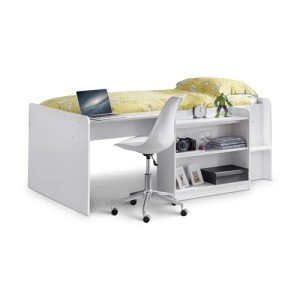A Comprehensive Guide to Children's Bunk Beds: Styles, Benefits, and Safety Considerations
Bunk beds have become a popular choice for families looking to maximize space and provide a fun sleeping environment for kids. With their distinct style, they provide an innovative and practical service for shared bedrooms, playrooms, or perhaps guest lodging. This article checks out the various designs of children's bunk beds, their advantages, security considerations, and responds to some often asked questions.
The Allure of Bunk Beds
Kid's bunk beds are more than simply space-saving structures; they are also a gateway to adventurous dreams and imaginative play. Below is a detailed assessment of their many benefits.
Advantages of Bunk Beds
- Space-Saving: Bunk beds effectively use vertical space, making them a perfect option for smaller sized rooms.
- Spirited Design: Many bunk bed designs include slides, tents, and themed elements, stimulating creativity and excitement.
- Partner Sharing: Bunk beds are best for siblings sharing a space or accommodating slumber parties.
- Flexible Use: Some models can be separated into two specific beds, offering flexibility as children grow.
- Storage Options: Many bunk beds feature integrated drawer storage or racks, further enhancing their practicality.
Styles of Children's Bunk Beds
The variety of bunk beds offered today caters to different preferences and needs. Below is Going Listed here of some popular designs.
| Design | Description | Best For |
|---|---|---|
| Standard Bunk Bed | A traditional style featuring one bed stacked above another. | Brother or sisters sharing a room. |
| Loft Bed | Comparable to a bunk bed without the bottom bunk, permits an office or play location below. | Restricted space for play/desk. |
| L-Shaped Bunk Bed | 2 beds set up in an L-shape, frequently with additional sections for storage or play. | Unique room layouts. |
| Twin Over Full | A twin bed over a full bed, accommodating different sleep needs. | Growing children and teens. |
| High Sleeper | Stands even higher than a loft bed, normally including a desk or play location below. | Older kids needing more play/desk space. |
| Camping Tent Bunk Bed | Bunk beds with a canopy or tent-like structure, producing a cozy, fun space. | Active and imaginative children. |
Secret Features to Consider
When choosing the right bunk bed for children, the following functions are worth thinking about:
- Material: Bunk beds can be made from wood, metal, or a mix. Each has its unique aesthetic and sturdiness.
- Weight Capacity: Always validate the weight limit of the bunk bed to ensure it can accommodate your kids securely.
- Security Rails: Ensure the leading bunk has sturdy rails to prevent falls.
- Ladder Security: A properly designed ladder ought to provide easy and safe access to the upper bunk.
- Ending up: Ensure any surfaces are non-toxic and safe for children.
Security Considerations
Safety is vital when it pertains to children's bunk beds. The following standards need to be adhered to:
- Age Appropriateness: Generally, children under 6 years old should not sleep in the upper bunk due to safety dangers.
- Strong Construction: Ensure the frame and materials are solid and can support the weight without drooping.
- Routine Maintenance: Periodically check for loose screws, bolts, or other components that may require tightening.
- Clear Play Area: Keep the location around the bunk bed without toys and barriers to lessen tripping threats.
Setting Rules for Safe Use
Establishing guidelines for bunk bed use will help make sure safety:
- Limit Jumping and Climbing: Children must be encouraged versus jumping from the top bunk and getting on the sides.
- Supervising Sleepovers: Monitor young visitors while they are using the bunk bed for the very first time.
- Inform on Ladder Use: Teach how to use the ladder securely, highlighting the importance of dealing with the ladder when climbing or down.
Frequently Asked Questions
1. What age is appropriate for a child to oversleep the top bunk?
A lot of producers advise that kids need to be at least six years of ages to sleep in the upper bunk. This standard is developed to mitigate the danger of falls.
2. Can bunk beds be customized?
Yes, numerous manufacturers provide customizable options, consisting of colors, products, and extra features like drawers or desks.
3. Are bunk beds safe for weight?
Bunk beds have weight limits, generally ranging from 200 to 400 pounds, depending upon the design and material. Constantly examine the producer's requirements.
4. How do I keep and clean up a bunk bed?
Frequently look for loose parts, keep the bed clean by wiping down surface areas, and make sure the bedding is fresh to promote a safe and sanitary sleep environment.
5. Can bunk beds be separated into specific beds?
Lots of bunk beds come with an alternative to separate them into 2 specific beds, offering long-term flexibility.
Children's bunk beds are more than simple furniture; they are a functional, flexible, and imaginative part of a kid's room. With various styles offered and numerous safety factors to consider to keep in mind, parents can select the perfect bed that fits their space, meets their children's needs, and instills a sense of experience. By understanding the advantages, designs, and precaution related to bunk beds, families can develop a delightful and safe sleeping environment for their children. Whether for brother or sisters sharing a space or space-saving services, bunk beds remain a beloved option for many households.

